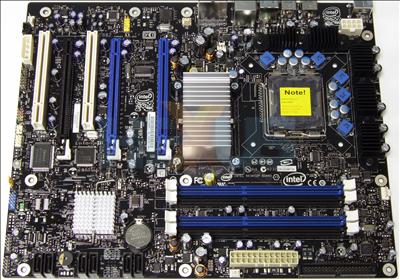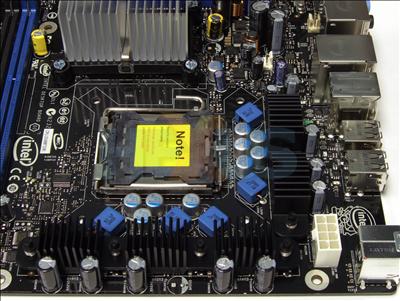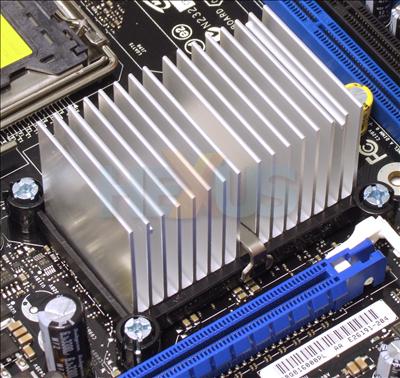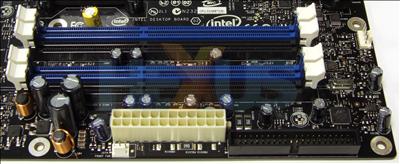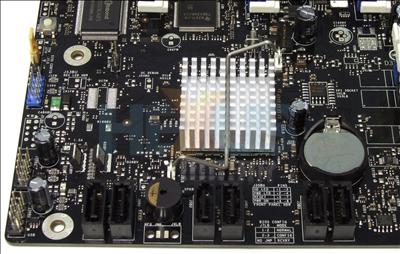Intel DX48BT2 layout and features
The £164-priced Intel DX48BT2 is based, of course, around Intel's X48 chipset, an evolution of the X38 which we took at here. The X48 chipset features official support for 1600MHz FSB CPUs and a few new memory tweaks, supporting either DDR2 up to 1066MHz or DDR3 up to 1600MHz, it may be able to squeeze out that extra bit of performance compared to the X38 it replaces.
The layout of the DX48BT2 is pretty decent. Power connectors are generally located in the ideal locations, with the exception of the Molex connector at the top-left corner of the board - which proves inconvenient, forcing you to route an extra cable to the far side of the board.
There are ample fan headers with two 4-pin connectors one for the CPU and one for a rear fan (top left of the picture), and three 3-pin connectors for a rear fan, MCH (top-centre of the picture) and front fan (next to the 24-pin ATX connector).
The layout is not without issues however; placement of the memory slots so near the primary PCIe slot means that memory cannot be readily installed or removed with a graphics card in-situ.
A major annoyance is the lack of a clear CMOS button or jumper block, which means you have to remove the battery to clear it.
The area surrounding the CPU socket is free of obstructions, meaning you shouldn't run into issues installing larger coolers. The VRMs are cooled by simple aluminium heatsinks that use airflow from the CPU cooler.
The northbridge cooler is, again, a passive aluminium heatsink. The bundle contains a fan-clip for a 40mm fan, but no fan is included. The heatsink got hot to the touch during extended testing, so good airflow to the area is highly recommended.
Intel's DX48BT2 opts for DDR3 support; which should offer greater
performance over its DDR2 brethren, albeit at the cost of
substantially higher RAM prices.
Unfortunately we ran into a number of
issues with the DX48BT2's memory support, from memory refusing to post
at its specified speeds, to what appears to be an 'Intel-knows-best
policy' where you cannot run tighter-than-SPD timings. Considering many
manufacturers use reference JEDEC specs in their SPDs for
compatibility purposes, even their low-latency, high-performance
models, you may not be able to run some RAM at its optimal settings.
Using XMP profiles didn't help - the wrong timings were still
detected and manually adjusting them resulted in a failure to POST.
The ICH9R southbridge, despite being passively cooled, ran cool throughout testing. Intel even provide a decorative plastic southbridge cover in the bundle which further emphasises little cooling is necessary. I wouldn't suggest installing the cover, though.
The ICH9R provides six SATA2 ports. They are not of the front-facing variety, which may prove a problem when running longer graphics cards in multi-GPU configurations.
The expansion-slot layout is pretty good, allowing flexible
configuration when running either one or two
graphics cards. Two
PCIe 2.0 x16 lanes allow for
full-bandwidth, dual-card CrossFireX support, whilst a
third PCI-E slot (x16 physical/x4 electrical) facilitates a
third graphics card, RAID controller, sound or physics card. Two PCI
slots are provided, running a pair of dual-slot Radeon cards
will
result in the loss of one PCI slot, but you still have the
choice
of either a PCI or PCIe connection for additional expansion.
Rear connectivity features eight USB2.0 connections, two eSATA, one
FireWire, one Ethernet and audio ports.
The on-board sound features Dolby Home Theatre, which includes Dolby Digital Live real-time encoding for outputting a digital multi-channel audio stream to a home-theatre system via the optical S/PDIF-out (sadly, there is no Coaxial support). You're also provided with multi-channel analogue connections, too.
The FireWire connection on our sample was possibly faulty, as neither the standard Akasa USB/FireWire combo enclosure or a Western Digital MyBook 2TB enclosure would be detected when plugged in.






